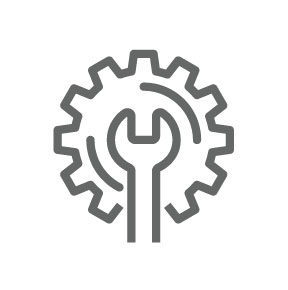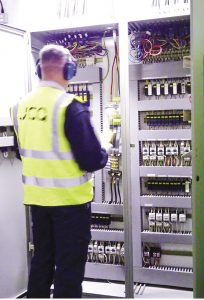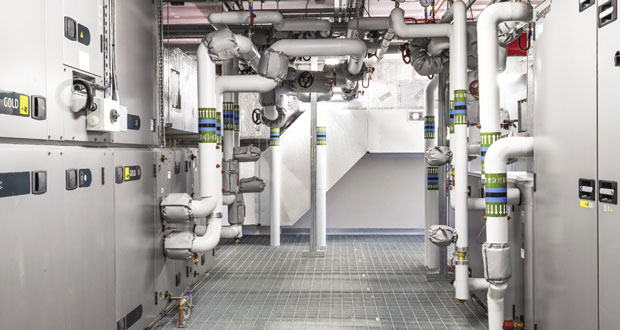CHANGES REQUIRED TO ENGINEERING WORKING METHODS
Based on these recommendations it was necessary to ascertain the original basis of design and review the original design intent for the building ventilation and cooling systems to identify the appropriate changes to make the building more COVID-19 secure. We would advocate the following basic process:
 Establish original basis of design – this is the design capability of the building systems
Establish original basis of design – this is the design capability of the building systems- Gap analysis to identify deviation from original basis of design – modifications that have taken place to support change of use for example
- Engage with end-users regarding predicted usage short, medium and long term
- Formulate design proposals to optimise building systems
- Agree on optimisation strategy ensuring approach is holistic
- Implement proposed changes
- Update record information following change control procedure
- Monitor and evaluate effectiveness of change
Using JCA’s in-house design and consultancy division(v) we were ideally placed to support our customers with this review and to quickly identify and scope improvement measures. To assist with the communication of these measures we were able to provide revised 3D imagery for offices so that staff could understand, prior to arrival, what changes were to be experienced and how their individual safety had been considered during the lockdown phase.
Another recommendation by REHVA was to avoid recirculation of air via centralised air handling units. This posed significant challenges to commercial offices served by VAV (variable air volume) systems, in which heating and cooling is fundamentally dependent upon the centralised recirculation of air. When designing the fitout of one such office, we were able to draw on our experience in healthcare to introduce an ultraviolet germicidal irradiation (UVGI) in the return air ducts of the existing air handling plant to inactivate viruses and bacteria. Again, due diligence of both the original and current basis of design was imperative in retrospectively introducing such measures.
At the start of the lockdown phase it was necessary to review a significant amount of data regarding revised methods of working, to evaluate the implications to each task conducted by our employees and our sub-contractors, and it wasn’t unusual to have to respond to changing information on a daily basis. Company-wide we implemented short and frequent “huddles” so that information could be shared between operational and back-office teams swiftly and concisely. This allowed our approach to be as dynamic as possible and provided an invaluable route for site-wide feedback regarding the consequences of implementing revised working practices.
OPERATING IN CRITICAL ENVIRONMENTS
As specialists in the area of data centre design, build and operations – one element that was particularly relevant to us was the safety of engineers operating in high air recirculation rate, low air change rate environments such as data centres and switch rooms because of the low levels of airborne dilution. Fresh air is an expensive commodity to introduce to a building and whilst it is required for healthy human occupancy, it is used in minimal quantities within technical environments, predominantly for pressurisation purposes. These spaces require high air re-circulation rates to provide the cooling to IT equipment and electrical plant such as UPS’s (Uninterruptable Power Systems). Once again referring to the REHVA COVID-19 guidance document it could be deduced that an enclosed space with high air turbulence and low ventilation rates would create an environment with increased risk of aerosol transmission. As such we made it mandatory that engineers operating in environments such as these did so wearing FFP2 grade face masks(vi), based on an altruistic approach, trying to prevent the release of airborne viruses within the turbulent air streams.
 The closing and reopening of commercial offices represented challenges, but there was at least a degree of time available to develop and stress test the necessary strategies. As a multi-faceted engineering company providing design consultancy, project delivery and maintenance services we work across a range of industry sectors, including healthcare, life sciences and data centres. For our engagements with our clients in these sectors the opportunity to pause, reflect and plan did not exist. From our 40+ key workers maintaining a major London hospital, to our design team overseeing the commissioning stages of a 64 bed intensive care unit the demand for their time, commitment and professionalism could not have been greater. We had significant design and build data centre upgrade/expansion projects ongoing, the timely completion of which was required to maintain the increasingly vital digital infrastructure that was sustaining a population many of whom were working, or schooling, from home.
The closing and reopening of commercial offices represented challenges, but there was at least a degree of time available to develop and stress test the necessary strategies. As a multi-faceted engineering company providing design consultancy, project delivery and maintenance services we work across a range of industry sectors, including healthcare, life sciences and data centres. For our engagements with our clients in these sectors the opportunity to pause, reflect and plan did not exist. From our 40+ key workers maintaining a major London hospital, to our design team overseeing the commissioning stages of a 64 bed intensive care unit the demand for their time, commitment and professionalism could not have been greater. We had significant design and build data centre upgrade/expansion projects ongoing, the timely completion of which was required to maintain the increasingly vital digital infrastructure that was sustaining a population many of whom were working, or schooling, from home.
Collectively we have risen to the many challenges that COVID-19 presents, every member of the team and our trusted supply chain performed, and continues to perform, fantastically. To continue to offer a high-quality service to our clients we didn’t lose service on any critical facilities and many strategies that we deployed initially in response to the virus will be accommodated into our daily working practices. Necessity has certainly driven innovation in operations and for all the obvious downside from the pandemic it has helped to highlight the importance of the building services sector to industry at large, something we should capitalise on and utilise to encourage young engineers to pursue a career in building engineering services.
(i) www.fmj.co.uk/sfg20-definitive-standard-building-maintenance/
(ii) www.thebesa.com/knowledge/shop/products/sfg30-maintenance-task-schedules-mothballing-and-reactivation/
(iii) www.thebesa.com/
(iv) www.rehva.eu/activities/covid-19-guidance
(v) https://jca.co.uk/fit-out/cat-a-b/
(vi) www.healtheuropa.eu/are-face-masks-useful-for-stopping-the-spread-of-covid-19/99087/





